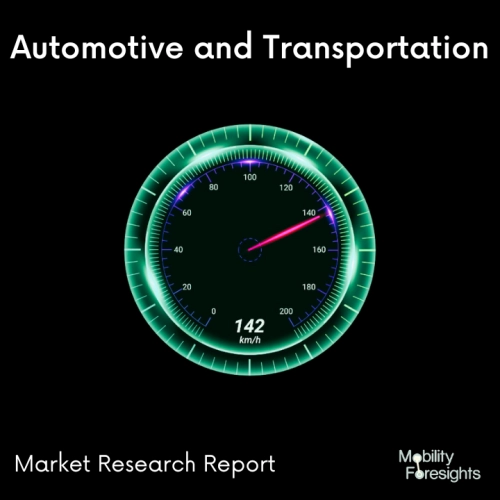
- Get in Touch with Us

Last Updated: Apr 25, 2025 | Study Period: 2023-2030
The automotive lighting market has seen significant progress since the advent of high-power LEDs.Low-beam headlights, for example, were traditionally produced by using a single bulb as the light source and a system of lenses to image the light onto the road to generate the cut-off pattern.
The lamp light sources were replaced with the first generation of LEDs, but comparable optics were still employed. LEDs had the benefit of being considerably brighter and smaller than traditional lamps, and as the luminance (brightness) of the LEDs grew, so did the optics.
Most automobiles on the road nowadays use halogen bulbs to illuminate their headlights. Vehicle owners desire to replace traditional halogen bulbs with HPLEDs to improve night vision without altering the existing headlight assembly.
Though High Power Light Emitting Diodes (HPLED) are effective light sources for replacing halogen bulbs, standard headlights are not built for HPLEDs, and hence substituted HPLEDs fail quickly owing to inadequate cooling. The goal of this project is to create a small cooling system for a traditional headlight assembly that can handle HPLEDs.
This paper proposes an air-cooled system with a small heat sink. Various heat sink sizes were modeled to determine the dimensions of the compact heat sink.
ANSYS was used to simulate this. For this investigation, a popular SUV's headlight was chosen, and thorough testing was performed on a level black surface in the absence of extraneous lighting.
The horizontal passing beam of Halogen and HPLED is assessed in terms of lux at various measurement sites. The trial findings show that the HPLED consumes only one-third of the energy used by halogen bulbs to produce the same intensity of light.
When the cooling fan was run at laminar flow conditions, the suggested cooling system lowered the junction temperature.
The luminous intensity of the HPLED, on the other hand, increased as the junction temperature decreased.
Some of the most recent significant breakthroughs in LED technology include a reduction in source size, as well as increases in brightness and tolerance (the ability to precisely align the optical components in relation to the light source).
These advancements enable additional capabilities, such as the advanced dynamic beam (ADB) system. To simulate a low-beam, a light section in this system can be dynamically shut off. This movable low-beam then detects impending and approaching vehicles.
The ADB system is made feasible by the LEDs quick, digitally controlled full-on/full-off switching time.The new LED technology may also combine many purposes. LEDs, for example, can be used as daytime running lights to improve vehicle visibility throughout the day.
High-brightness LEDs are used to generate lines of light, and with the correct lens or reflector-based optical design, they may provide both highway lighting with a headlight and daytime running light capabilities in the same form factor.
Directly raising the brightness reduces the size of the optics and headlights, saving space and weight.Chip-on-lead frame technology enables the creation of LED bulb replacements and new light engines (light sources comprised of LEDs, a main lens, a printed circuit board or leadframe, and other electrical components) for rear illumination.
As with headlighting efforts, they are also incorporating LEDs and other components into rear-lighting bulbs. These new lead frame-based bulbs have standard optical, electrical, and mechanical connections and may thus be simply changed.

The Global Automotive High Power LED Market accounted for $XX Billion in 2022 and is anticipated to reach $XX Billion by 2030, registering a CAGR of XX% from 2023 to 2030.
Nichia and Infineon introduce the first high-definition micro-LED matrix solution in the industry.
A German luxury automobile will include the first high-definition light engine micro-LEDs for headlamp applications. In recent years, automotive LED lighting technology has advanced significantly as a tool for car makers to improve driving comfort and road safety.
In this context, adaptive driving beam matrix LED technology has become a key headlamp function for selective road lighting.Both businesses are now introducing the first fully integrated micro-LED light engine for HD adaptive driving beam applications. It combines high-definition quality with the strongest light output in the industry.
This approach provides a four-times larger field-of-view with much greater light output than any other contemporary micromirror based HD matrix-light solution, enabling a unique automotive lighting experience.
As a result, the enhanced HD light may alert drivers to potential risks by highlighting persons or objects on or near the side of the road. It may also broadcast road markers to help drivers through construction zones or intersections.
Furthermore, functionalities like glare-free high beam and bending light operate more accurately and smoothly than existing adaptive driving beam solutions.
This raises the driver's degree of road safety and comfort.The new HD light engine employs Nichia's micro-LED technology as well as an Infineon integrated LED driver IC capable of driving all micro-LEDs independently using pulse-width modulation (PWM).
Furthermore, the driver IC controls each micro-LED individually and enables on-chip temperature monitoring for optimal thermal control.
The video signal from the light pattern generating unit may be sent at high speeds thanks to integrated video connections. Infineon's driver IC, unlike existing HD matrix solutions, only activates the LEDs required for a light pattern.
When compared to micromirror-based HD matrix solutions on the market, this significantly improves the energy efficiency of the PLS light engine in a considerably smaller form factor.
In the future, this will allow for smaller and thinner headlamp designs. Furthermore, the new HD light engine allows for modifications that may be digitally programmed at the factory or triggered on demand by the car maker or driver.
For example, the various needs of left- and right-handed drivers may be taken into account, considerably improving user-friendliness. With all of these characteristics, the new HD light decreases
| Sl no | Topic |
| 1 | Market Segmentation |
| 2 | Scope of the report |
| 3 | Abbreviations |
| 4 | Research Methodology |
| 5 | Executive Summary |
| 6 | Introduction |
| 7 | Insights from Industry stakeholders |
| 8 | Cost breakdown of Product by sub-components and average profit margin |
| 9 | Disruptive innovation in the Industry |
| 10 | Technology trends in the Industry |
| 11 | Consumer trends in the industry |
| 12 | Recent Production Milestones |
| 13 | Component Manufacturing in US, EU and China |
| 14 | COVID-19 impact on overall market |
| 15 | COVID-19 impact on Production of components |
| 16 | COVID-19 impact on Point of sale |
| 17 | Market Segmentation, Dynamics and Forecast by Geography, 2023-2030 |
| 18 | Market Segmentation, Dynamics and Forecast by Product Type, 2023-2030 |
| 19 | Market Segmentation, Dynamics and Forecast by Application, 2023-2030 |
| 20 | Market Segmentation, Dynamics and Forecast by End use, 2023-2030 |
| 21 | Product installation rate by OEM, 2023 |
| 22 | Incline/Decline in Average B-2-B selling price in past 5 years |
| 23 | Competition from substitute products |
| 24 | Gross margin and average profitability of suppliers |
| 25 | New product development in past 12 months |
| 26 | M&A in past 12 months |
| 27 | Growth strategy of leading players |
| 28 | Market share of vendors, 2023 |
| 29 | Company Profiles |
| 30 | Unmet needs and opportunity for new suppliers |
| 31 | Conclusion |
| 32 | Appendix |